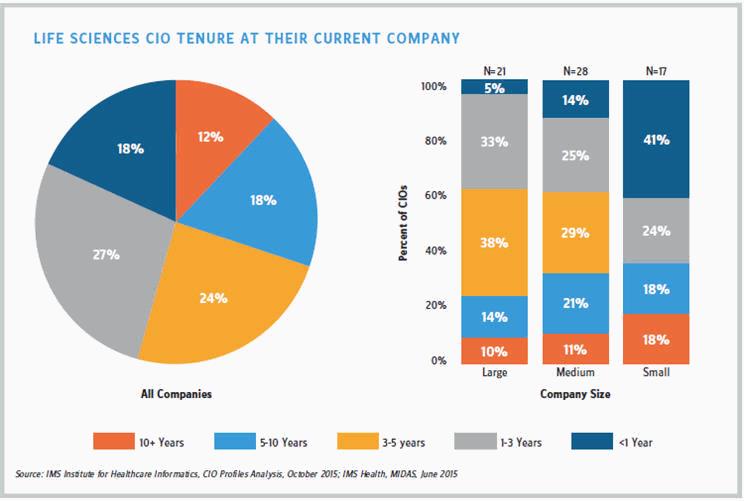The Changing Role Of The Pharma CIO
By Gail Dutton, Contributing Writer
Follow Me On Twitter @GailLdutton
"Companies that recognize the opportunities associated with digital transformation are more likely to bring in fresh blood,” Murray Aitken, executive director, IMS Institute, says.
To that point, half of biopharma CIOs have been in their current job less than three years, and 70 percent less than five years, according to a recent IMS Health survey. For those CIOs, they understand — and often desire — that this position goes well beyond any traditional responsibilities associated with developing and maintaining information technology and computer systems. Instead, this new breed of CIO helps to add strategic value that shapes the direction of their organizations.
VISION AND LEADERSHIP ARE TOP CIO ATTRIBUTES
“Technology is a cornerstone for the CIO. But for the CIO to be a cornerstone for the business, that person must have the skills to influence and motivate people in a variety of ways to drive the business forward,” says Alain Serhan, core leader of digital health initiative for the executive search and advisory firm Egon Zehnder. To access those skills, the CEO and CIO need to talk more about the company’s future and how the CIO can help shape that future than about IT itself. This means that vision and leadership are at least as, if not more, valuable than technical skills for the CIO. As Mike Gammons, CIO at Sucampo, points out, “The last CIO I worked for was a leader but not a technology person. She built an efficient, multinational technology group. Technical decisions, however, were largely left to those with more extensive technical knowledge.”
Gammons’ former company had the luxury of specialization. That CIO focused on developing an IT vision and managing the change necessary to get there. Sucampo, as a smaller company, lacks that luxury. In addition to being a visionary and change manager, Gammons also must be a technology expert.
CUSTOMERS ARE TOP-OF-MIND FOR CIOs
Forward-thinking CEOs, according to the IMS survey, are seeking CIOs who are consumer-centric, digitally fluent, understand data, adaptable, and able and willing to lead change.
One of the biggest mind-set changes is the transition from technology-centric to customer-centric roles, Gammons says, “The CIO function originated because the organization needed someone to make all the devices in an enterprise work together. Now we’re focusing on identifying business problems that can be solved with technology.”
The recent IMS survey supports that observation. “A transformation is underway,” Aitken says. “The CIO is transitioning from someone who keeps the IT infrastructure running to someone who is attuned to the company and thinks about technological solutions to meet current and future challenges.” While this trend affects CIOs in all industries, its impact on life sciences is profound. Life sciences finally are implementing IT best practices from other industries such as the use of cloud computing and hybrid cloud and private computing environments, software as a service (SaaS), and platform as a service (PaaS), catalyzed by the increasing complexity of bringing clinical developments to the marketplace at a time when payers, providers, and regulators all seek evidence of real-world efficacy.

"When CIOs asked large pharma R&D heads how they could help, they generally were told they couldn’t."
Murray Aitken
Executive director, IMS Institute
“This environment expands CIOs’ opportunities to shape the way information is accessed and applied throughout their companies,” Aitken points out. “For example, the ability to mine complex datasets from health plans and health records enables companies to study data and develop insights into how patients actually use and respond to specific medications outside of clinical trials.”
Those insights are valued by researchers as well as by drug marketers. “Managing that information and making it accessible across functions throughout the enterprise, while preserving its timeliness, integrity, and patient privacy, is the role of the CIO,” Aitken says.
OTHER “CHIEF” ROLES COMPETE FOR DOMINANCE
Although innovative CIOs are leading the digital transformation, others are being outmaneuvered. Individual business units trying to maintain control over information and speed of access are creating their own IT experts.
That counters the overall trend in IT toward curating a single source of truth that is kept up-to-date in real or near-real time and used by multiple departments for varying purposes. The return to siloed data risks fragmenting information and causing inefficiencies as business functions struggle with conflicting or inaccessible information.
The proliferation of chief digital officers, chief security officers, chief innovation officers, and other chiefs also dilutes the authority of the CIO over information. “How the development of additional ‘chief’ roles ultimately affects the CIO role depends on who is in the CIO role and how much opportunity the CIO seizes,” Aitken says.
Serhan suggests these ancillary chief roles are stopgap measures while the business units become more attuned to the new digital realities. “In 10 years, organizations will have evolved so there will be no need for such titles as chief digital marketing officer.”
Kim Green, chief information security officer for Zephyr Health (a Big Data analytics firm), sees multiple data chiefs as a natural step in companies’ digital transformation. “I believe we will continue to see new roles in technology leadership, driven by evolutions in various industries.”
Zephyr, for instance, doesn’t have a CIO. Instead, its chief security and privacy officer and its VP of engineering jointly address the company’s information needs. Green considers this collaboration an integral part of product design, development, and delivery. “Building these concepts [of data security and access] into your product is one of the greatest values leaders in these roles can bring.”
CIOs BRING STRATEGIC VALUE
Regardless of how the IT leadership is structured, its strategic value is based upon the ability to provide access to information on a global scale. That requires strengthening their business understanding so they know the goals of each business unit and how those entities actually work, as well as enhancing their own technical knowledge so they are current regarding new and emerging technologies that may present new business opportunities for their organizations.
Deploying predictive analytics is one example. Companies using some of the newest analytics applications can better position their drugs by using data to identify buyers most amenable to new products, those with relationships with competitors, and current and future thought leaders. Big data analytics, predictive analytics, and cloud computing are integral to supplying new levels of information. Yet, despite successes in aerospace and other industries, they are just starting to penetrate life sciences companies. IT industry trade journals cover these topics extensively, as well as trade associations like AFCOM (formerly the Association for Computer Operations Management) and conferences like Data Center World.
CLOUD-SAVVY CIOs SEIZE OPPORTUNITIES
“Life sciences companies are adopting the cloud now,” says Michael Hughes, CIO, Anacor Pharmaceuticals. Typically, companies first migrate their application test beds to the cloud, followed by email and storage. Once those are functionally successful, they may migrate applications and eventually the IT infrastructure (servers, switches, and other hardware) to the cloud.
Cloud adoption typically is the first step toward other IT innovations. The ability to hand off certain tasks to cloud hosts is particularly important for small companies that lack large IT staffs and resources. When Hughes was at Kythera Biopharmaceuticals (since acquired by Allergan), “I moved the entire IT operation to the cloud. Our cloud host had more robust security safeguards than most small companies could provide.”
Sucampo’s Gammons has migrated 40 percent of the company’s IT operations to the cloud, including antivirus software and, soon, storage and email. He says cloud computing allows managers to rethink implementations like enterprise resource planning (ERP) and finance systems, using new technology to cut implementation and reporting times, in some cases, in half.
The immediate benefit is increased agility. IT shops free up time by handing off to cloud providers tasks that otherwise would be performed in-house. That extra time may be used to review and update policies and procedures to reflect new working arrangements and IT infrastructure, for example. This also helps CIOs think strategically, becoming more proactive.
Predictive analytics is still in its pioneering phase, used by less than 10 percent of companies in the IMS survey. When deployed, these systems can provide extremely granular views of existing data for accurate real-world insights into compliance, personalized cost-benefit analyses, and other issues. “The role of the CIO is to enable that value to be unlocked,” Aitken stresses.

OTHER INDUSTRY EXPERIENCE SPURS INNOVATION
As the CIOs begin to think about technology in terms of how it can help their organizations advance, they are more likely to adopt current and emerging technologies. While a strict regulatory environment often is blamed for the stodgy pharmaceutical IT environment, Hughes, who came to biotech from NASA’s Jet Propulsion Laboratory, says that’s not the whole story. “Other industries are just as heavily regulated, but their IT departments are innovative.” He blames the inertia on researchers and executives who’ve become comfortable with the status quo.
For example, traditionally, pharmaceutical companies were insular, preferring to hire CIOs with deep pharmaceutical experience. Now that’s changing.
The IMS survey shows that about two-thirds of life science CIOs have experience in other industries. Consequently, they are bringing the risk-reduction strategies they’ve used in aerospace, finance, and other regulated industries to their current positions. By implementing those best practices and adapting them to the biopharmaceutical industry, they are crafting innovative IT systems that meet the life sciences’ rigorous audit requirements.
Hughes himself is a case in point. Based on his multi-industry insights on the relative values of risk and innovation, he took a chance on a new cloud provider. Consequently, Kythera became one of Veeva Vault’s first customers.

"Other industries are just as heavily regulated, but their IT departments are innovative."
Michael Hughes
CIO, Anacor Pharmaceuticals
WHAT CEOs WANT
While innovative CEOs are embracing digital opportunities, many others are still figuring them out. “CEOs don’t know what to ask from IT in this new digital world,” Serhan notes. Too often, they think about IT in terms of siloed functions like R&D analytics or, enterprise-wide, as a service provider. CIOs, therefore, need to become more relevant to the core organization.
The problem isn’t limited to CEOs. “When CIOs asked large pharma R&D heads how they could help, they generally were told they couldn’t,” Aitken says. Business unit leaders don’t understand IT’s capabilities and don’t know what to ask to learn.
Yet, CIOs are uniquely equipped to bridge the technology- pharma gap and help their companies develop the most advanced R&D organizations in the world. As the IMS survey shows, 66 percent of the CIOs have advanced degrees, including 43 percent with MBAs.
To bridge that gap effectively, CIOs must become proactive. They must develop relationships with business unit leaders so they understand their challenges and their goals. “The more complex the challenge, the earlier CIOs should be involved,” Aitken says. “They should be integral to their organization’s development.”
To bridge that gap effectively, CIOs must become Maximizing these new prospects requires CIOs to embrace a culture of change and to identify and seize opportunities. They also must develop horizontal efficiencies across the enterprise.
To bridge that gap effectively, CIOs must become “CIOs have tremendous influence in companies. It’s important they continue to provide core strategic and transformational leadership that supports new business models and creates speedier, more secure paths to market for their products,” Green says. Simultaneously, “CIOs must help manage acquisitions and the aggregation of new data sources within an IT system that enhances business continuity and minimizes business risks.”
JOINING THE C-SUITE IS IRRELEVANT … OR IS IT?
While many suggest the CIO should be part of the senior management team, that premise is open to debate. Currently, less than 25 percent of CIOs are members of the executive team, the IMS survey reports.
“I’m not convinced the C-suite is appropriate for the CIO,” Gammons says. “A lot happens there that shouldn’t involve the CIO.” Instead, he suggests CIOs are better focusing on their specific areas of expertise.
“Our natural role is to apply enterprise-level thinking to solve the challenges of the functional areas’ business problems. Rather than serving in the C-suite, I have independent relations with each member of the management team and report periodically to the board,” he says.
Aitken, however, sees value in inclusion. “With the increased flow of more complex data, CIOs may play a more central role that drives organizational change. We at IMS argue that the CIO role is of sufficient strategic importance to be a part of the executive leadership. If it isn’t, this is a sign the company isn’t fully embracing digital transformation or that the CIO isn’t seizing the existing opportunities.”
As digital capabilities and possibilities increase, so will the need for comprehensive, enterprise-wide data management. Consequently, Aitken predicts, “The CIO role will continue to grow in importance.”
